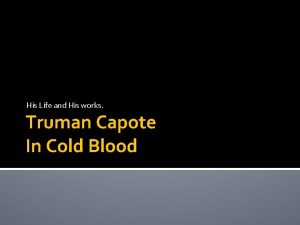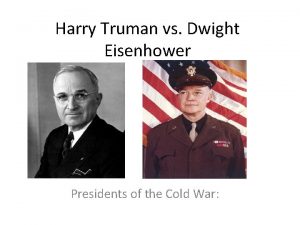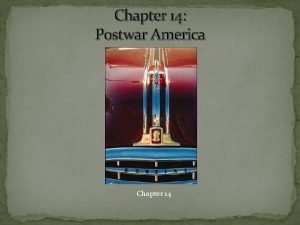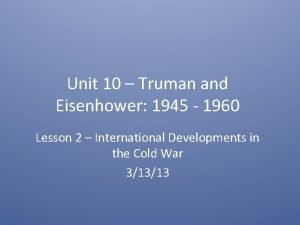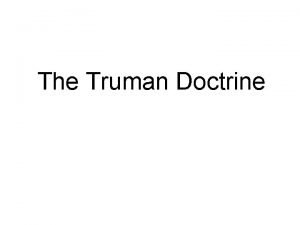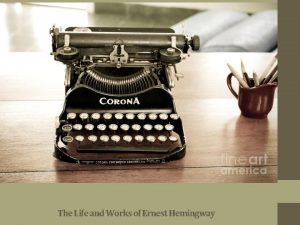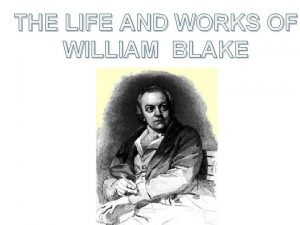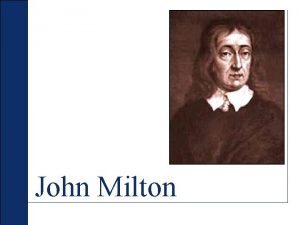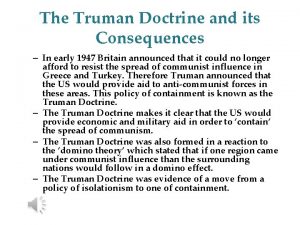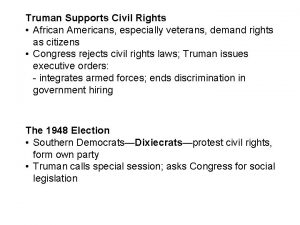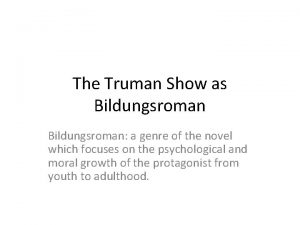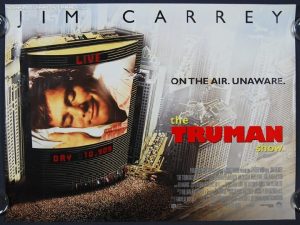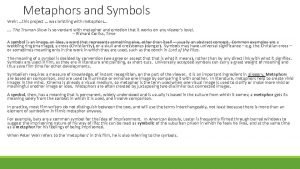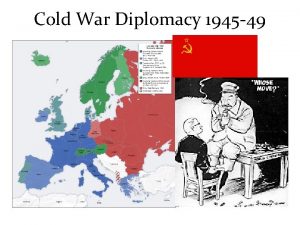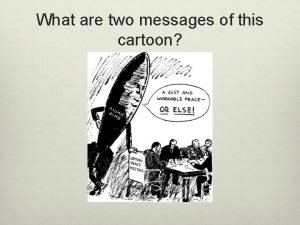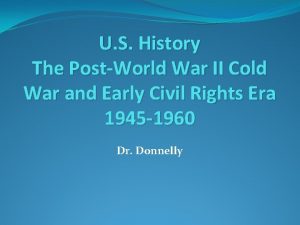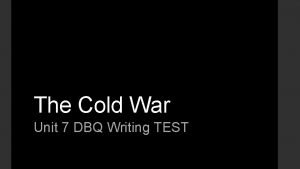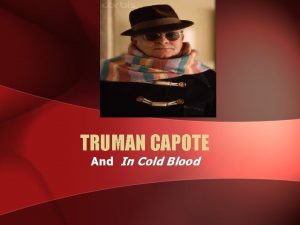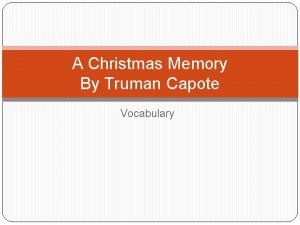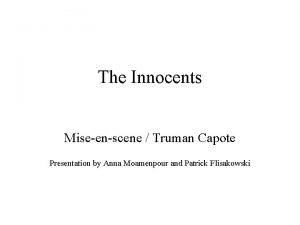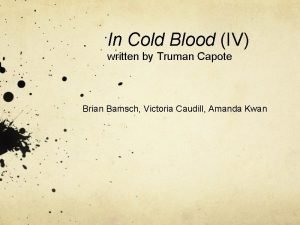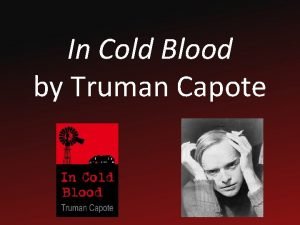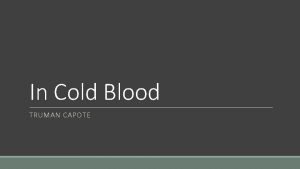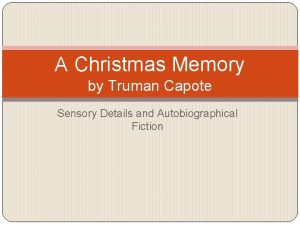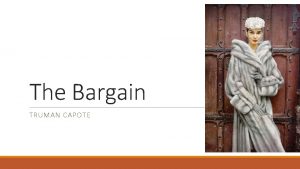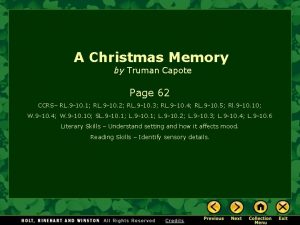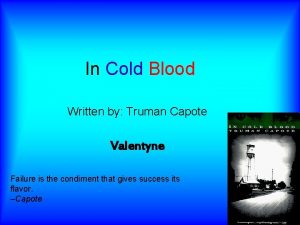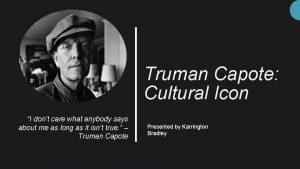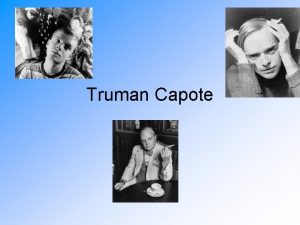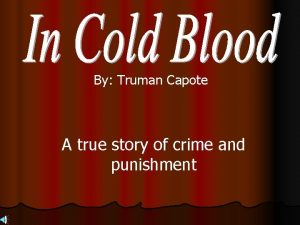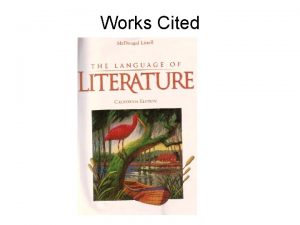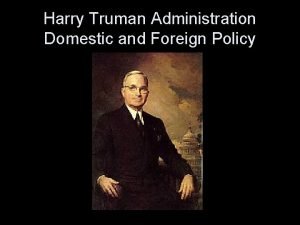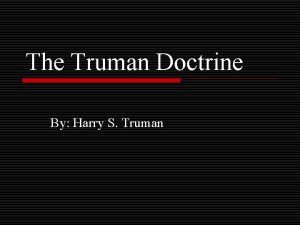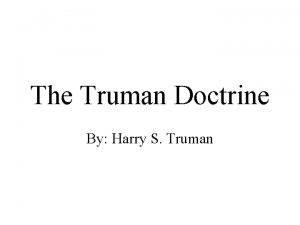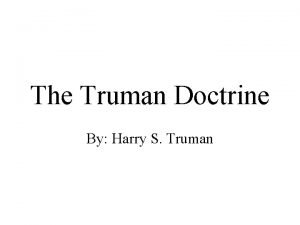His Life and His works Truman Capote In

























- Slides: 25

His Life and His works. Truman Capote In Cold Blood

The Man…

�Truman Capote is best known for Breakfast at Tiffany's and In Cold Blood �Truman pioneered a new literary genre, the Nonfiction Novel, with what many claim as his ultimate work, In Cold Blood, the story of a rural Kansas murder recounting journalistic facts with the flair of prose.

Early Life �Born in New Orleans, he spent most of his early childhood with his aunts and distant cousins in Alabama. �Capote was born Truman Streckfus Persons on September 30, 1924 to Lillie Mae Faulk and Arch Persons.

Continued �Lillie Mae's early rejection of Truman was to be a sign of how her relationship with her son would remain throughout his life. Abandoned by his mother with his cousins, Lillie Mae was free to begin separating herself from her husband Arch. �Lillie Mae, now free to try again to reach social elevation, found what she was looking for in Joseph Capote. She and Capote married and she moved to New York City with Joe to begin her new life, a life that rarely included her son.

Continued… �Truman also had the good fortune of meeting a friend in his southern neighbor, Harper Lee (To Kill a Mockingbird). �Truman was the basis for Lee's character, Dill, in her famous book and Truman is rumored to have helped Lee write the novel. �The two remained friends throughout and Lee would later accompany Truman in his research about the Kansas murders that would become In Cold Blood.

Dreams and Aspirations… �As smart and as sharp as Truman was, he was not very interested in school. He was, however, consumed with writing. He envisioned himself writing for the elite magazine, The New Yorker. �In 1941, while repeating his senior year of high school, Truman got a job as a copy boy for the magazine he idolized. .

Popularity �Truman always maintained a high, lispy voice and boyish looks. Combined with his short stature, this led many to assume that he was much younger than he was. His appearance often led to his advantage as many of the important figures that would help his career took on a motherly or fatherly role with him.

Early Career � Truman had joined The New Yorker in hopes that he would learn more about his craft and that they would eventually hire him as a writer. The New Yorker, however, was not interested in hiring a copy boy. � In 1944 he left the magazine, (either resigned or was fired) for offending Robert Frost. � Leaving the New Yorker was one of the best things to happen to Capote. Soon he began submitting his stories (Miriam, Tree of Night, My Side of the Matter) to more suitable magazines including Mademoiselle and Harper's Bizarre.

Continued… �The contrast of southern life and big city society, along with Truman's sexual themes in many of his stories, helped define Capote as a writer. �Through all his successful writings, Truman still felt that he was lacking something. He was looking to create something new, not just a new story, but a new way of telling a story. When Truman read about the 1959 killings of the Clutter Family in rural Holcomb Kansas, Truman had found his muse. http: //www. capotebio. com/

Clutter Family Found “In Cold Blood” – The Daily Perspective 1959: Clutter Family found "In Cold Blood” Four members of the Clutter family were found murdered today on their farm in Holcomb, Kansas. The killers had no apparent motive, as Finley County Attorney General Duane West, quoted in The Daily Independent, stated that "Clutter was a prominent man and it was a fine family— so fine that it's difficult to envisage a possible motive. ”

The Story Behind the Story �Herbert Clutter was a devout Methodist and a widely respected self made man who had established himself as a very successful and prosperous farm owner from modest beginnings. �Morally strict and conservative, he employed as many as 18 farm hands, and former employees reportedly admired and respected him for his fair treatment and good wages. �His wife and four children were also respected within the community.

Continued �Two ex-convicts on parole from Kansas State Penitentiary, Richard “Dick” Hickock and Perry Edward Smith entered their family home and committed the acts of robbery and murder on November 15, 1959. �While in jail, a fellow inmate had told Hickock of a safe that was kept on the premises and often contained large sums of money.

Continued �Hickock became obsessed with the idea of obtaining the money, and with no witnesses to his crime, planned on fleeing to Mexico to start a new life. �The information Hickock was provided about the safe proved to be incorrect as Herb Cutter conducted all his business by cheque and no money was ever kept on site.

The Murder �On the day of the murder, Hickock and Smith drove across Kansas, located the Clutter household and entered the premises while the family lay sleeping. �After they roused the family and discovered there was no money to be found, Smith – who was notoriously prone to violent outbursts – slit Herb’s throat and then shot him in the head.

Continued… �The rest of the family members were killed by a single gun shot to the head. �In his confession, Smith claimed that Hickock murdered the two women but Hickock maintained that Smith was responsible for all four deaths. �Both mean pleaded temporary insanity at the trial, but after evaluation it was determined that both men were in fact sane. �After 5 years on death row, both men were executed in April of 1965.

Truman Capote’s Account �In Cold Blood was originally published in The New Yorker as a four-part series, beginning on September 25, 1965. It sold out immediately. �It was published by Random House for the first time as a novel in 1966.

Limitations of The American Dream �In Cold Blood presents a conflicted image of the notion of the American Dream. �The text portrays a prosperous, homogenous, middle-class community, Holcomb, Kansas, that is forced to question its values and its sense of safety and security when the Clutter family is murdered. �Capote’s text was among a growing number of novels and plays written in the early part of the twentieth century that questioned the validity of the promises made by the American Dream.

Continued… These texts warn Americans not to take the Dream for granted and encourage readers to recognize that the American Dream is available only to a small group of individuals while excluding a vast majority of people from its promises.

Continued… The Clutter family in particular is among the most affluent citizens in the Holcomb community. Having expanded his River Valley Farm into a lucrative operation with several employees, Herb Clutter is able to provide a comfortable life for his family, providing a modern lifestyle that includes automobiles and televisions: “Always certain of what he wanted from the world, Mr. Clutter had in large measure obtained it. ” For families like the Clutters, the American Dream has been realized.

Continued… But In Cold Blood also portrays the failure of the American Dream. For Richard Hickock and Perry Smith, a modern, comfortable middleclass lifestyle is unattainable. Raised in a dysfunctional family, Perry Smith considers himself to be misunderstood and, like Richard Hickock, falls into a life of petty crime. Unable to create a stable existence, the two ex-cons accept their roles as societal outsiders and survive by stealing and writing false checks.

The Non-Fiction Novel The non-fiction novel presents real events through the use of literary techniques generally associated with fiction narratives. � In the case of In Cold Blood, Capote used news- paper accounts, investigative reports, letters, and interviews to piece together the story of the Clutter murders and the subsequent hunt for and eventual execution of Richard Hickock and Perry Smith. � Capote traveled to the Holcomb area just months after the murders, and he spent six years collecting information, interviewing residents, and observing the work of the Kansas Bureau of Investigations under the leadership of Al Dewey. � Yet, like a novel, the story is presented in vivid sentences and filled with evocative descriptions, poignant word choice, and lyrical images. �

Narrative Point-of-View �Within each section of the text, the narrative viewpoint shifts between presenting events and details from the perspective of the Clutter family, the citizens of Holcomb, and the Kansas Bureau of Investigations investigators to the perspectives of Richard Hickock and Perry Smith. � Capote himself never interjects the narrative with his authorial voice. Instead, he relies on the voice of his characters, including letters, interviews, newspaper accounts, etc. , to present the events.

Continued � Whenever Capote presents the perspective of the Clutters and their neighbors, his sentences are welldeveloped, complex, with vivid, descriptive diction. � Whenever the perspective shifts toward the points of view of Perry Smith and Richard Hickock, the sentence structure tends to be shorter and frequently interfused with fragments. � Additionally, sections presenting Perry and Dick’s world often utilize colloquialisms and slang. The shift in narrative tone helps reinforce the social discrepancy between the comfortable middle-class world of the Clutters and the lower-class, poverty-stricken world of Dick and Perry.

Major Themes �Limitations of the American Dream �Socio-economic status �Family �Loss of Innocence �Self-image
 Degreeworks truman
Degreeworks truman Alfredo capote
Alfredo capote Epp nivel b
Epp nivel b Street works revision
Street works revision Eisenhower and truman compare and contrast
Eisenhower and truman compare and contrast Chapter 14 postwar america
Chapter 14 postwar america Lesson 1 truman and eisenhower
Lesson 1 truman and eisenhower Sclc and sncc venn diagram
Sclc and sncc venn diagram Marshall plan and truman doctrine
Marshall plan and truman doctrine George orwell life and works
George orwell life and works Ernest hemingway prose
Ernest hemingway prose William blake life summary
William blake life summary John milton born
John milton born Whats the truman doctrine
Whats the truman doctrine The truman doctrine worksheet answers
The truman doctrine worksheet answers Truman supports civil rights
Truman supports civil rights The truman show genre
The truman show genre Truman show fingers crossed meaning
Truman show fingers crossed meaning Symbols in the truman show
Symbols in the truman show Truman foreign policy vs eisenhower
Truman foreign policy vs eisenhower Consequences of the truman doctrine
Consequences of the truman doctrine Which explains the message of this cartoon?
Which explains the message of this cartoon? 723 truman ave tallahassee fl
723 truman ave tallahassee fl Nasser and prokofiev 1953
Nasser and prokofiev 1953 Dewey defeats truman
Dewey defeats truman When did nicholas novikov write the telegram
When did nicholas novikov write the telegram
